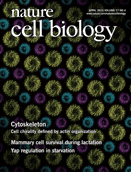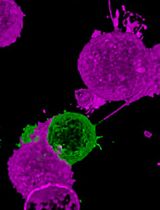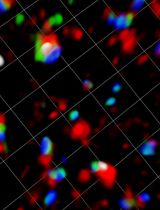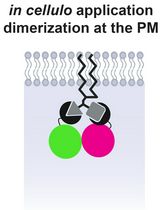- EN - English
- CN - 中文
Actin Retrograde Flow in Permeabilized Cells: Myosin-II Driven Centripetal Movement of Transverse Arcs
透性化细胞中肌动蛋白逆流:横向弧的肌球蛋白II激发的向性运动
发布: 2016年03月05日第6卷第5期 DOI: 10.21769/BioProtoc.1743 浏览次数: 9526
评审: Lin FangRalph BottcherAnonymous reviewer(s)
Abstract
Numerous biological functions such as cytokinesis, changes in cell shape and cell migration require actomyosin-driven cellular contractility. However, the detailed mechanism of how contractile forces drive cellular processes are difficult to decipher due to the complexity of the intracellular environment. In particular, the mesoscopic description of the myosin II-dependent actin retrograde flow in cell lamellum is missing. Here, we describe a methodology for detergent extraction of cell, which preserves integrity of the actin cytoskeleton. This semi-in vitro cell model allows for the observation, using light microscopy, and quantification of changes in the actin cytoskeleton resulting from the activation of cellular contractility upon addition of ATP. This assay also allows for the evaluation of the effects of actin-associated proteins and other related factors in the modulation of the actin contractile activities. Here, we demonstrate the retrograde flow of a well-known actin-based structures- transverse arcs, which are myosin IIA-containing structures that emerge at the boundary between lamellipodium-lamellum and move centripetally in myosin II-dependent fashion.
Keywords: Actin fibers (肌动蛋白纤维)Materials and Reagents
- 35-mm ibidi’s hydrophobic uncoated μ-dishes for cell culture (ibidi GmbH, catalog number: 80131 )
- 1 x 1 cm polydimethylsiloxane (PDMS) stamp containing microfeatures of circles (area, 1,800 μm2; center-to-center distance, 100 μm)
Note: For a detailed protocol on preparation of PDMS stamps and micro-contact printing see Théry and Piel (2009) and Tee et al., (2015). - NuncTM Cell Culture Treated Flasks with Filter Caps (Thermo Fisher Scientific, catalog number: 136196 )
- Human foreskin fibroblast (ATCC, catalog number: SCRC-1041 )
- Growth medium: Dulbecco’s modified Eagle’s medium (DMEM) high glucose (Thermo Fisher Scientific, catalog number: 11965-092 ), supplemented with
- TrypLETM Express Enzyme (Thermo Fisher Scientific, catalog number: 12604013 )
- PBS (1x), pH 7.4 (Thermo Fisher Scientific, catalog number: 10010-023 )
- Fibronectin (Merck Millipore Corporation, catalog number: 341635 )
- Imidazole (Sigma-Aldrich, catalog number: I15513 )
- KCl (First BASE Laboratories Sdn Bhd, catalog number: BIO-1300 )
- Magnesium chloride (MgCl2) (Sigma-Aldrich, catalog number: M8266 )
- EDTA (First BASE Laboratories Sdn Bhd, catalog number: BIO-1050 )
- Ethylene glycol-bis (2-aminoethylether)-N, N, N′, N′-tetraacetic acid (EGTA) (Sigma-Aldrich, catalog number: E3889 )
- 2-Mercaptoethanol (Sigma-Aldrich, catalog number: M6250 )
- TritonTM X-100 (Sigma-Aldrich, catalog number: X100 )
- Polye (ethylene glycol) MW35,000 (PEG) (Sigma-Aldrich, catalog number: 81310 )
- Protease inhibitors cocktail (for use with mammalian cell and tissue extracts, DMSO solution) (Sigma-Aldrich, catalog number: P8340 )
- N, N-Dimethylformamide (DMF) (Sigma-Aldrich, catalog number: 227056 )
- Methanol (Thermo Fisher Scientific, catalog number: M/4000/17 )
- Sterile Milli-Q water
- Alexa Fluor® 488 Phalloidin (Thermo Fisher Scientific, catalog number: A12379 ) (see Recipes)
- Dark phalloidin [Phalloidin from Amanita phalloides (≥90%)] (Sigma-Aldrich, catalog number: P2141 ) (see Recipes)
- Adenosine 5’-triphosphate disodium salt hydrate (ATP) (Sigma-Aldrich, catalog number: A6419 ) (see Recipes)
- Extraction buffer A (see Recipes)
- Extraction buffer B (see Recipes)
- Staining solution (see Recipes)
- Contractility buffer (see Recipes)
Equipment
- Confocal microscope equipped with 100x oil immersion objective
- 37 °C on-stage incubation chamber
Software
- Image J software [National Institutes of Health (NIH)] (http://imagej.nih.gov/ij/)
Procedure
文章信息
版权信息
© 2016 The Authors; exclusive licensee Bio-protocol LLC.
如何引用
Tee, Y. H. and Bershadsky, A. D. (2016). Actin Retrograde Flow in Permeabilized Cells: Myosin-II Driven Centripetal Movement of Transverse Arcs. Bio-protocol 6(5): e1743. DOI: 10.21769/BioProtoc.1743.
分类
分子生物学 > 蛋白质 > 蛋白质-蛋白质相互作用
细胞生物学 > 细胞成像 > 活细胞成像
您对这篇实验方法有问题吗?
在此处发布您的问题,我们将邀请本文作者来回答。同时,我们会将您的问题发布到Bio-protocol Exchange,以便寻求社区成员的帮助。
Share
Bluesky
X
Copy link















